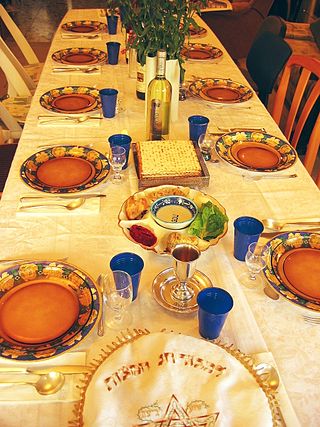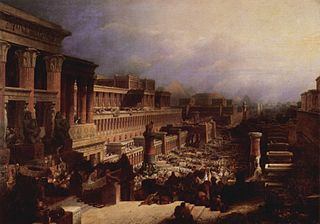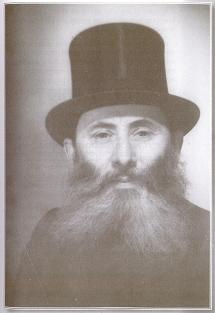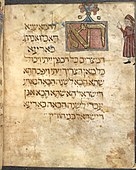
Matzah, matzo, or maẓẓah is an unleavened flatbread that is part of Jewish cuisine and forms an integral element of the Passover festival, during which chametz is forbidden.

Passover ; Biblical Hebrew: חַג הַפֶּסַח, romanized: Ḥag haPesaḥ) is a major Jewish holiday, one of the three pilgrimage festivals, that celebrates the Biblical story of the Israelites' escape from slavery in Egypt. Pesach starts on the 15th day of the Hebrew month of Nisan which is considered the first month of the Hebrew year. The Hebrew calendar is adjusted to align with the solar calendar in such a way that 15 Nisan always coincides with Sunday, Tuesday, Thursday, or Saturday. The Hebrew day starts and ends at sunset, so the holiday starts at sunset the day before. For example, in 2023, 15 Nisan coincides with Thursday April 6. Therefore, Pesach starts at sundown Wednesday April 5. The word Pesach or Passover can also refer to the Korban Pesach, the paschal lamb that was offered when the Temple in Jerusalem stood; to the Passover Seder, the ritual meal on Passover night; or to the Feast of Unleavened Bread. One of the biblically ordained Three Pilgrimage Festivals, Passover is traditionally celebrated in the Land of Israel for seven days and for eight days among many Jews in the Diaspora, based on the concept of yom tov sheni shel galuyot. In the Bible, the seven-day holiday is known as Chag HaMatzot, the feast of unleavened bread (matzah).

The Passover Seder is a ritual feast at the beginning of the Jewish holiday of Passover. It is conducted throughout the world on the eve of the 15th day of Nisan in the Hebrew calendar. The day falls in late March or in April of the Gregorian calendar; Passover lasts for seven days in Israel and eight days outside Israel. Jews traditionally observe one seder if in Israel and two if in the Jewish diaspora. The Seder is a ritual involving a retelling of the story of the liberation of the Israelites from slavery in ancient Egypt, taken from the Book of Exodus (Shemot) in the Torah. The Seder itself is based on the Biblical verse commanding Jews to retell the story of the Exodus from Egypt: "You shall tell your child on that day, saying, 'It is because of what the LORD did for me when I came out of Egypt.'" At the seder, Jews read the text of the Haggadah, an ancient Tannaitic work. The Haggadah contains the narrative of the Israelite exodus from Egypt, special blessings and rituals, Talmudic commentaries, and Passover songs.

The Haggadah is a Jewish text that sets forth the order of the Passover Seder. According to Jewish practice, reading the Haggadah at the Seder table is a fulfillment of the mitzvah to each Jew to tell their children the story from the Book of Exodus about God bringing the Israelites out of slavery in Egypt, with a strong hand and an outstretched arm.
Hallel is a Jewish prayer, a verbatim recitation from Psalms 113–118 which is recited by observant Jews on Jewish holidays as an act of praise and thanksgiving.

Charoset, haroset, or charoises is a sweet, dark-colored paste made of fruits and nuts eaten at the Passover Seder. According to the Talmud its color and texture are meant to recall mortar which the Israelites used when they were enslaved in Ancient Egypt as mentioned in Tractate Pesahim of the Talmud. The word charoset comes from the Hebrew word cheres ".

The Passover Seder plate is a special plate containing symbolic foods eaten or displayed at the Passover Seder. The purpose of the Passover Seder plate is to show all the foods that perpetuate and emphasize the ideas of the people of Israel, and are designed to express the uniqueness of the Seder. Another idea is to keep the foods close and ready for Seder night.

Bo is the fifteenth weekly Torah portion in the annual Jewish cycle of Torah reading and the third in the Book of Exodus. The parashah constitutes Exodus 10:1–13:16. The parashah tells of the last three plagues on Egypt and the first Passover.

Pesachim, also spelled Pesahim, is the third tractate of Seder Moed of the Mishnah and of the Talmud. The tractate discusses the topics related to the Jewish holiday of Passover, and the Passover sacrifice, both called "Pesach" in Hebrew. The tractate deals with the laws of matza and maror, the prohibitions against owning or consuming chametz (leaven) on the festival, the details of the Paschal lamb that used to be offered at the Temple in Jerusalem, the order of the feast on the first evening of the holiday known as the Passover seder, and the laws of the supplemental "Second Pesach".

Afikoman based on Greek epikomon [ἐπὶ κῶμον] or epikomion [ἐπικώμιον], meaning "that which comes after" or "dessert"), a word originally having the connotation of "refreshments eaten after the meal", is now almost strictly associated with the half-piece of matzo which is broken in two during the early stages of the Passover Seder and set aside to be eaten as a dessert after the meal.
David Abudarham, referred to as Abudarham, Abudraham, or Avudraham, was a rishon who lived at Seville and was known for his commentary on the Synagogue liturgy.
Passover songs are songs from the seder, the festive meal associated with the Jewish festival of Passover.

Menachem Mendel Kasher was a Polish-born Israeli rabbi and prolific author who authored an encyclopedic work on the Torah entitled Torah Sheleimah.

Ma Nishtana are the first two words in a phrase meaning "Why is this night different from all other nights?" The phrase appears at the beginning of each line of The Four Questions, traditionally asked via song by the youngest capable child attending Passover Seder.
In Judaism, when the Eve of Passover falls on Shabbat, special laws regarding the preparation for Passover are observed.
The Great Sabbath is the Sabbath immediately preceding the Passover on the night of the 14th of Nisan, named on account of the prophecy from Malachi, traditionally read on this day, which foretells the return of Elijah the prophet to announce the "great and terrible Day of the Lord" It is commemorated in the Christian calendar as Lazarus Saturday.

The White House Passover Seder was an annual private dinner held at the White House on the Jewish holiday of Passover during the presidency of Barack Obama. Obama initiated it in 2009 for his family, staff members, friends, and their families. The gathering recited the Passover Haggadah, discussed the themes of the Passover Seder and their relation to current events, and partook of a holiday-themed meal. Obama hosted and attended the Seder each year from 2009 to 2016. It was the first Passover Seder to be conducted by a sitting U.S. president in the White House.
L'Shana Haba'ah B'Yerushalayim, lit. "Next year in Jerusalem", is a phrase that is often sung at the end of the Passover Seder and at the end of the Ne'ila service on Yom Kippur. Its use during Passover was first recorded by Isaac Tyrnau in his 15th century CE book cataloging the Minhaggim of various Ashkenazi communities.

The Maxwell House Haggadah is an English-Hebrew Passover Haggadah introduced by the Maxwell House company as a marketing promotion in 1932 and printed continuously since that time. With over 50 million copies in print, it is the best known and most popular Haggadah among American Jews, and is considered a cultural icon. It is used at Passover Seders in homes, schools, senior centers, prisons, and the United States Army, and was the edition used by President Obama and his guests at the White House Passover Seder conducted yearly from 2009 to 2016. In 2011 a new English translation replaced archaic phrases in the original and also incorporated gender-neutral language.

The Birds' Head Haggadah is the oldest surviving illuminated Ashkenazi Passover Haggadah. The manuscript, produced in the Upper Rhine region of Southern Germany in the early 14th century, contains the full Hebrew text of the Haggadah, a ritual text recounting the story of Passover – the liberation of the Israelites from slavery in ancient Egypt – which is recited by participants at a Passover Seder. The text is executed in block calligraphy and accompanied by colorful illustrations of Jews performing the Seder practices and reenacting Jewish historical events. The Birds' Head Haggadah is so called because all Jewish men, women, and children depicted in the manuscript have human bodies with the faces and beaks of birds. Non-Jewish and non-human faces are blank or blurred. Numerous theories have been advanced to explain the unusual iconography, usually tied to Jewish aniconism. The Haggadah is in the possession of the Israel Museum in Jerusalem, where it is on permanent exhibition.

















